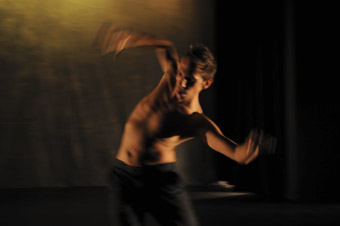a mindful body-in-place
pauline manley: martin del amo, it’s a jungle out there

Martin Del Amo, It’s a Jungle Out There
photo Heidrun Löhr
Martin Del Amo, It’s a Jungle Out There
MARTIN DEL AMO IS UBIQUITOUS. HE POPS UP WILD HAIRED AND UNDIE-CLAD SO OFTEN ON THE SYDNEY UNDERGROUND DANCE LANDSCAPE THAT EXPECTATION IS FASHIONED BY FAMILIARITY. YET HE SURPRISES. HIS INSOUCIANT BELIEF IN THE INHERENT WORTH OF WHAT HE HAS TO SAY GIVES HIS WORK A TRADEMARK INTENSITY THAT RESULTS FROM THE PIQUANCY OF FASCINATION AND RESEARCH. WHATEVER DEL AMO IS INVESTIGATING, IT IS DONE WITH A FEROCIOUS AND METICULOUS ATTENTION THAT IS A LUST TO DISCOVER, UNCOVER AND REVEAL.
It is this lust that saves It’s a Jungle Out There from cliché. The work’s stated intention is to explore “the modern city as an ever changing organism.” Within such a topic lies potential for trite statements about regulation, hurried temporalities, frayed nerves and harried obedience. And Del Amo does make such statements. But he tempers predictability with the truths that emerge from research. He does not merely condemn ‘the city’ as a Gomorrah of undisputed self-interest; he also investigates it as a site of fertile possibility. Dance becomes embodied investigation and his body asks: what is it to exist in this landscape?
The invited opening night crowd warble in. Just sitting atop this diffuse murmur is another muffled voice. Del Amo is crossing the stage in straight lines, incessantly speaking numbers into a head mike. I am surprised by his modest and conservative clothing and tamed hair. Nearly corporate, neat, almost sharp. Gail Priest’s soundscape rumbles subterraneously and like the hum of a city goes almost unnoticed until it erupts into occasional porcelain scratches that hurt my teeth. In the black and grey space the numbers get louder and del Amo gets closer. The dancer’s shadows loom large and small, walking away from self. Numbers engorge themselves into ridiculousness then transform into pithy scenic descriptions. Del Amo’s voice remains incessant and constant, occasionally yelling to break the hypnotic patina. Now the script is akin to rapping, and rhythm is meaning. This first section is building with an almost foreboding rhythmic curve that stops me laughing at the very funny things he throws at us. As the performance unfolds this rise to climax and subsequent release will occur with regularity, even predictability, but it still works.
In his attention to detail, del Amo asks me to notice it too. In this opening section, walking is the dance. Each step is lovely. Each step is soft, loving the ground. Focused feet articulate bones, shifting in repetition and variation. In cities we walk. Cities make us walk. And this particular walking, slightly knock-kneed, sure but not bored, is both heartbeat and journey.
The climax rips apart the hypnosis of repetition. Lights flash and flare blindingly to shake us out of the zone. Almost reassuringly del Amo has removed his smart city shirt and his shadowed and naked torso swings and creaks like a rusty gate in the wind.
Section 3 presents as a lecture. Quietly del Amo brings out a microphone stand and delivers a monologue about a particular kind of urban agoraphobia where sufferers are compelled to build life-like models of the outside world inside the safety of their homes. Like so many of the artist’s observations, the potency resides in an admixture of disquiet and humour.
The disquiet tumbles into section 4 where del Amo runs and runs, round and round, carving the neverending figure eight pathways that now sit layered on the linear grids, mashing up space, making mess. To Priest’s repetitious pulse he runs backwards and forwards, he dodges, weaves, reaches, turns, twists, throws with a kind of focused anxiety rooted in the torso. The legs keep running. He sweats. I am getting warmer. And I realise that one of del Amo’s gifts is the creation of atmosphere through an embodiment that knows exactly why it is doing what it is doing and will keep on doing it. His use of repetition, development and variation allows these atmospheres to build through diffusion, thickening of temperature and sculpted temporalities.
As his breathing calms, section 5 develops into a square dance of negotiation: small steps forward, back and side create little lines of direct action. Restraint and constraint drive the performance down to mad quantum ruminations. Do the little red and green men who live in traffic lights change location? Do they talk to each other?
Emerging from this performance I am close to wordless. Like leaving a David Lynch movie, I don’t quite know where I am. The sensation is dreamlike, but not fuzzy. This dream is ripe with observational truth, clarities born of flesh, rhythm and atmosphere. It is not the clarity of intellect but of mindful body-in-place. This is because Martin Del Amo is a researcher. He does not seek to manufacture but to authenticate. He writes: “as part of my research for this piece, I conducted a series of excursions to heighten my perception of the city’s impact on the body. They included walking backwards through Sydney’s CBD, walking blindfolded along Parramatta Road during rush hour and crawling on all fours in the historic part of The Rocks.” From these bleeding-for-art excursions, blood, body, breath and rhythm speak.
Campbelltown Arts Centre Contemporary Dance Program, It’s a Jungle Out There, performer, devisor Martin del Amo, composer, live sound Gail Priest, lighting designer Travis Hodgson, designer Paul Matthews; Campbelltown Arts Centre, Sydney, June 25-27
RealTime issue #92 Aug-Sept 2009 pg. 36






